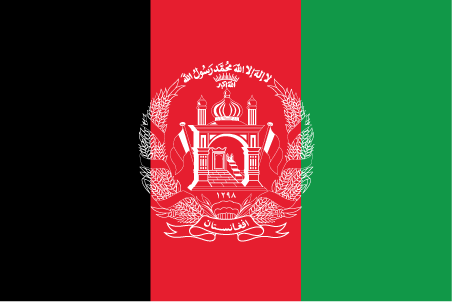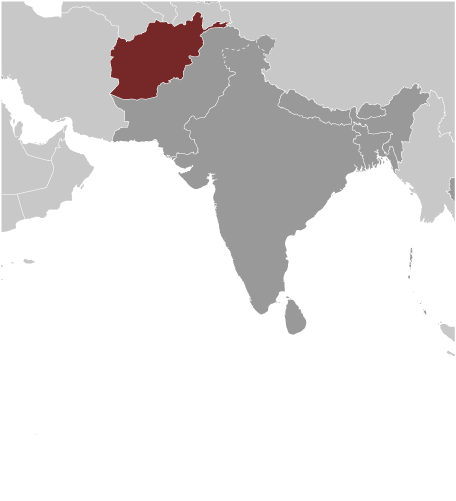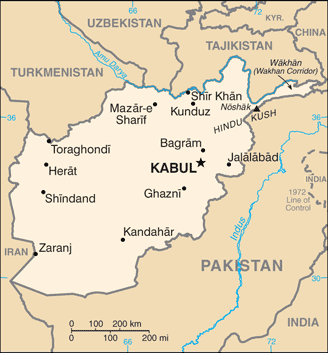|
Country name:
|

|
|
conventional long form: Islamic Republic of Afghanistan
conventional short form:
Afghanistan
local long form:
Jamhuri-ye Islami-ye Afghanistan
local short form:
Afghanistan
former:
Republic of Afghanistan
|
|
|
Government type:
|

|
|
Islamic republic
|
|
|
Capital:
|

|
|
name: Kabul
geographic coordinates:
34 31 N, 69 11 E
time difference:
UTC+4.5 (9.5 hours ahead of Washington, DC during Standard Time)
|
|
|
Administrative divisions:
|

|
|
34 provinces (welayat, singular - welayat); Badakhshan, Badghis, Baghlan, Balkh, Bamyan, Daykundi, Farah, Faryab, Ghazni, Ghor, Helmand, Herat, Jowzjan, Kabul, Kandahar, Kapisa, Khost, Kunar, Kunduz, Laghman, Logar, Nangarhar, Nimroz, Nuristan, Paktika, Paktiya, Panjshir, Parwan, Samangan, Sar-e Pul, Takhar, Uruzgan, Wardak, Zabul
|
|
|
Independence:
|

|
|
19 August 1919 (from UK control over Afghan foreign affairs)
|
|
|
National holiday:
|

|
|
Independence Day, 19 August (1919)
|
|
|
Constitution:
|

|
|
sixth constitution drafted 14 December 2003 - 4 January 2004; signed 16 January 2004; ratified 26 January 2004
|
|
|
Legal system:
|

|
|
mixed legal system of civil, customary, and Islamic law
|
|
|
International law organization participation:
|

|
|
has not submitted an ICJ jurisdiction declaration; accepts ICCt jurisdiction
|
|
|
Suffrage:
|

|
|
18 years of age; universal
|
|
|
Executive branch:
|

|
|
chief of state: President of the Islamic Republic of Afghanistan Hamid KARZAI (since 7 December 2004); First Vice President Mohammad FAHIM Khan (since 19 November 2009); Second Vice President Abdul Karim KHALILI (since 7 December 2004); note - the president is both the chief of state and head of government
head of government:
President of the Islamic Republic of Afghanistan Hamid KARZAI (since 7 December 2004); First Vice President Mohammad FAHIM Khan (since 19 November 2009); Second Vice President Abdul Karim KHALILI (since 7 December 2004)
cabinet:
25 ministers; note - ministers are appointed by the president and approved by the National Assembly
(For more information visit the World Leaders website  ) )
elections:
the president and two vice presidents elected by direct vote for a five-year term (eligible for a second term); if no candidate receives 50% or more of the vote in the first round of voting, the two candidates with the most votes will participate in a second round; election last held on 20 August 2009 (next to be held on 5 April 2014)
election results:
Hamid KARZAI reelected president; percent of vote (first round) - Hamid KARZAI 49.67%, Abdullah ABDULLAH 30.59%, Ramazan BASHARDOST 10.46%, Ashraf GHANI 2.94%; other 6.34%; note - ABDULLAH conceded the election to KARZAI following the first round vote
|
|
|
Legislative branch:
|

|
|
the bicameral National Assembly consists of the Meshrano Jirga or House of Elders (102 seats, two-thirds of members elected from provincial councils for 4-year terms, and one-third nominated by the president for 5-year terms) and the Wolesi Jirga or House of People (no more than 250 seats; members directly elected for five-year terms)
note:
on rare occasions the government may convene a Loya Jirga (Grand Council) on issues of independence, national sovereignty, and territorial integrity; it can amend the provisions of the constitution and prosecute the president; it is made up of members of the National Assembly and chairpersons of the provincial and district councils
elections:
last held on 18 September 2010 (next election expected in 2015)
election results:
results by party - NA; note - ethnicity is the main factor influencing political alliances; composition of Loya Jirga seats by ethnic groups - Pashtun 96, Hazara 61, Tajik 53, Uzbek 15, Aimak 8, Arab 8, Turkmen 3, Nuristani 2, Baloch 1, Pahhai 1, Turkic 1; women hold 69 seats
|
|
|
Judicial branch:
|

|
|
highest courts: Supreme Court or Stera Mahkama; consists of 9 judges
judge selection & term of office:
justices appointed by the president with the endorsement of the Wolesi Jirga; justices serve non-renewable 10-year terms
subordinate courts:
Cassation and sharia
|
|
|
Political parties and leaders:
|

|
|
note - the Ministry of Justice licensed 84 political parties as of December 2012
|
|
|
Political pressure groups and leaders:
|

|
|
other: religious groups; tribal leaders; ethnically based groups; Taliban
|
|
|
International organization participation:
|

|
|
ADB, CICA, CP, ECO, EITI (candidate country), FAO, G-77, IAEA, IBRD, ICAO, ICC (NGOs), ICRM, IDA, IDB, IFAD, IFC, IFRCS, ILO, IMF, Interpol, IOC, IOM, IPU, ISO (correspondent), ITSO, ITU, MIGA, NAM, OIC, OPCW, OSCE (partner), SAARC, SACEP, SCO (observer), UN, UNCTAD, UNESCO, UNIDO, UNWTO, UPU, WCO, WFTU (NGOs), WHO, WIPO, WMO, WTO
|
|
|
Diplomatic representation in the US:
|

|
|
chief of mission: Ambassador Eklil Ahmad HAKIMI
chancery:
2341 Wyoming Avenue NW, Washington, DC 20008
telephone:
[1] (202) 483-6410
FAX:
[1] (202) 483-6488
consulate(s) general:
Los Angeles, New York
|
|
|
Diplomatic representation from the US:
|

|
|
chief of mission: Ambassador James B. CUNNINGHAM
embassy:
The Great Masood Road, Kabul
mailing address:
U.S. Embassy Kabul, APO, AE 09806
telephone:
[93] 0700 108 001
FAX:
[93] 0700 108 564
|
|
|
Flag description:
|

|
|
three equal vertical bands of black (hoist side), red, and green, with the national emblem in white centered on the red band and slightly overlapping the other two bands; the center of the emblem features a mosque with pulpit and flags on either side, below the mosque are numerals for the solar year 1298 (1919 in the Gregorian calendar, the year of Afghan independence from the UK); this central image is circled by a border consisting of sheaves of wheat on the left and right, in the upper-center is an Arabic inscription of the Shahada (Muslim creed) below which are rays of the rising sun over the Takbir (Arabic expression meaning "God is great"), and at bottom center is a scroll bearing the name Afghanistan; black signifies the past, red is for the blood shed for independence, and green can represent either hope for the future, agricultural prosperity, or Islam
note:
Afghanistan had more changes to its national flag in the 20th century than any other country; the colors black, red, and green appeared on most of them
|
|
|
National symbol(s):
|

|
|
lion
|
|
|
National anthem:
|

|
|
name: "Milli Surood" (National Anthem)
lyrics/music:
Abdul Bari JAHANI/Babrak WASA
note:
adopted 2006; the 2004 constitution of the post-Taliban government mandated that a new national anthem should be written containing the phrase "Allahu Akbar" (God is Great) and mentioning the names of Afghanistan's ethnic groups
|
|
|
|
|





 )
)



